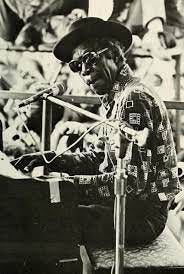Relaxing With the Professor
Tipitina’s Record Club Bows with a 1973 Professor Longhair Home Recording
If time travel was a real thing, one of the scenes I’d most want to visit would be New Orleans in the early 1970s. It was a time when the music of the city – that striding, endlessly propulsive second-line R&B – was running hot, and about to become the music of the world.
The artists we now think of as icons were all playing live regularly, in hospitable music dens like the Maple Leaf Bar as well as Bourbon street dives, developing material that made its way onto monstrously creative records. Through producer Allen Toussaint, the Meters were becoming the house band of choice for a staggering array of talents: The quartet backed Nola bandleader Dr. John on his breakthrough national hit “Right Place Wrong Time” and LP In The Right Place in 1973.
Within a year of that, the rhythm section backed British soul singer Robert Palmer on his sly and still-exceptional Sneakin’ Sally Through the Alley and created the mega hit “Lady Marmelade” for LaBelle. Of course the Meters were also making their own records: Rejuvenation came out in 1974. The next year, the Meters were booked as the opening act for a Rolling Stones tour.
The Crescent City’s keyboard titans – a partial list would include Toussaint, Henry Roeland Byrd aka Professor Longhair, Art Neville, Fats Domino, Eddie Bo, Champion Jack Dupree, Huey “Piano” Smith, James Booker – were all still active, an almost unprecedented concentration of major talent in a small city. While they all had instantly identifiable “sounds,” these musicians shared a common inspiration source: The spry “rum boogie” developed by Byrd in the late 1940s.
Fess, as he was known, was a musical omnivore: At the start of his professional career, he played the blues and R&B but was equally interested in the Afro-Cuban and Caribbean musics that had been part of New Orleans’ melting pot going back to Jelly Roll Morton’s “Latin tinge.” He mastered the syncopated rhythms of rumba, then fitted them onto original songs with Mardi Gras march beats and blues chord progressions. What sounds wonky when written down is actually transcendent as music – Byrd’s 1950s singles for Mercury, Federal and other labels have a life-affirming lightness, a blithe irreverence that many believe was a direct influence on such early rock pioneers as Little Richard. (Don’t get me started on how embarrassingly long it took for the Rock and Roll Hall of Fame to recognize Byrd….).
Byrd experienced several cycles of regional fame followed by obscurity; he was working as a janitor when some New Orleans music obsessives, including Quint Davis (the organizer of the New Orleans Jazz and Heritage festival) coaxed him out of retirement in 1970. Byrd turned in a rousing set at the first Jazz and Heritage Festival in Congo Square, and through his new manager Davis got signed to Atlantic records, which released his masterwork New Orleans Piano in 1972.
It’s possible to hear the energy of that particular era – the sense of long-overdue recognition and new possibilities on the horizon – throughout Fess At Home, a recording made by Davis at Byrd’s home on Rampart Street. It’s just Byrd singing and playing an upright piano that’s somewhat endearingly out of tune, and Alfred “Uganda” Roberts playing snappy conga and hand percussion. The material is what you’d hear at a Professor Longhair gig with a band – originals like “Tipitina” and “Big Chief,” blues evergreens like “Everyday I Have The Blues,” rehabilitated kitsch like “Rum and Coca-Cola” (co-written by the comic actor Morry Amsterdam of The Dick Van Dyke Show fame).
Byrd’s “thing” was rhythm-forward; he treated the piano as percussion, landing hard on the downbeats and brushing past barely audible ghost notes -- always using the changes in emphasis to reinforce the rhythm. Turns out he didn’t need a band to do that: One great delight of Fess At Home is hearing him sustain a constant, ping-ponging crosstalk between his right hand and his left. It’s the good kind of friction, swinging but not necessarily all in grid-sync: Sometimes it’s left to Roberts to establish a comfortable common ground. Which he does – I want to hear more of this duo.
One more thing that makes this release, the first in a subscription series of archival rarities on vinyl, an essential live artifact: The alternating currents of strength and intimacy that define Byrd’s vocal performances. We’re used to hearing him belt out the tunes, to be heard over a crowd. Here he doesn’t have to toil at all. He just rips and rollicks through the tunes, exerting no force at all. He doesn’t seem to care when his voice does one of those unexpected breaks, or how twisted some of his phrases become. He’s just in the spirit of the moment. At home. Having fun.
Do you want to smile today? Cue up “Bald Head,” Byrd’s whimsical rendition of his first-ever hit, and just try to keep a straight face. Hear that woozy piano, that whimsical voice? Haha. Gotcha. Works every time.
Fess At Home is the first release available in digital form from Tipitina’s Record Club, a subscription series devoted to archival rarities and titles that have been long out of print. The initiative was developed by the members of the band Galactic, who rescued the storied club Tipitina’s from closure during the pandemic. The Record Club will issue six titles each year, some drawn from the club’s extensive live archives and overseen by the club’s longtime sound engineer, Sonny Schneidau. Tipitina’s opened in 1977 and hosted countless performances by Professor Longhair and other Nola luminaries; among other early Record Club offerings is an uplifting James Booker performance at Tips in 1978 that includes covers of “A Taste of Honey,” “Malaguena” and the Beatles “Something.” Highly recommended!











